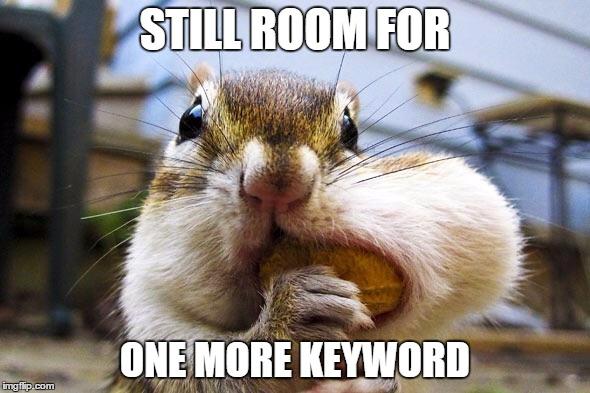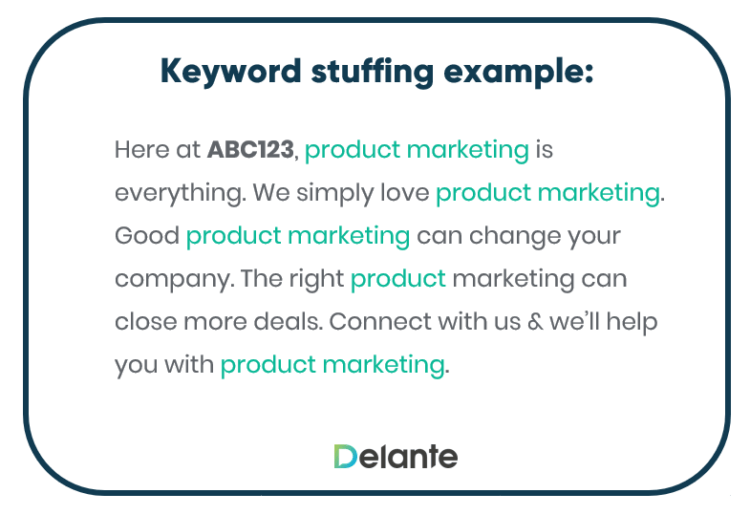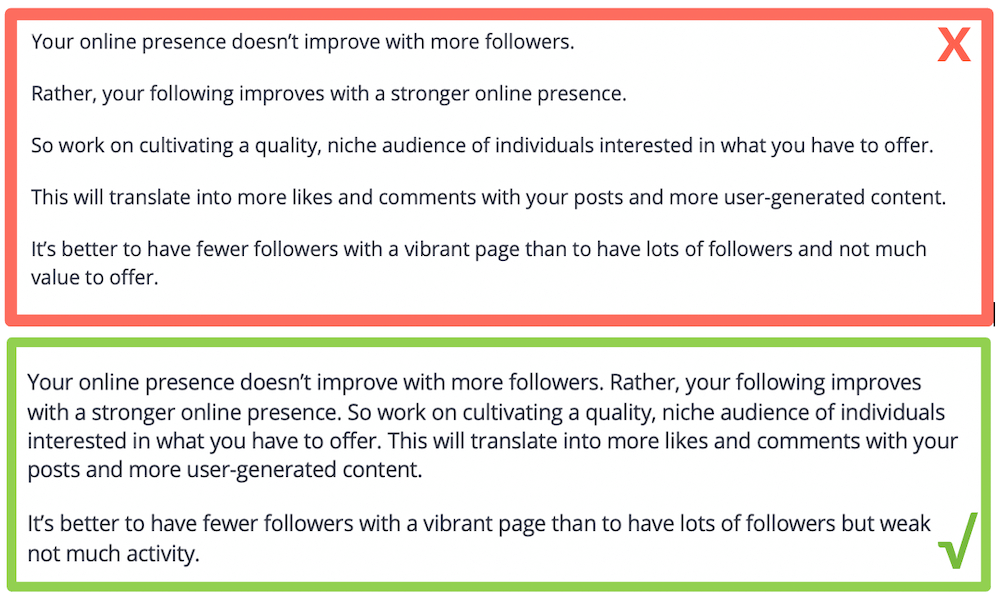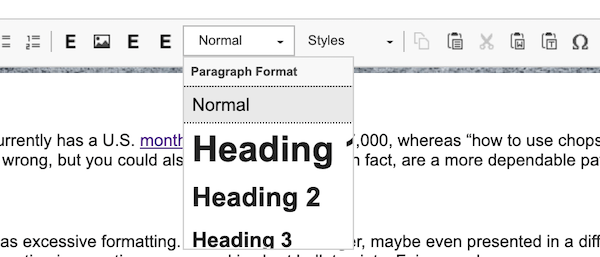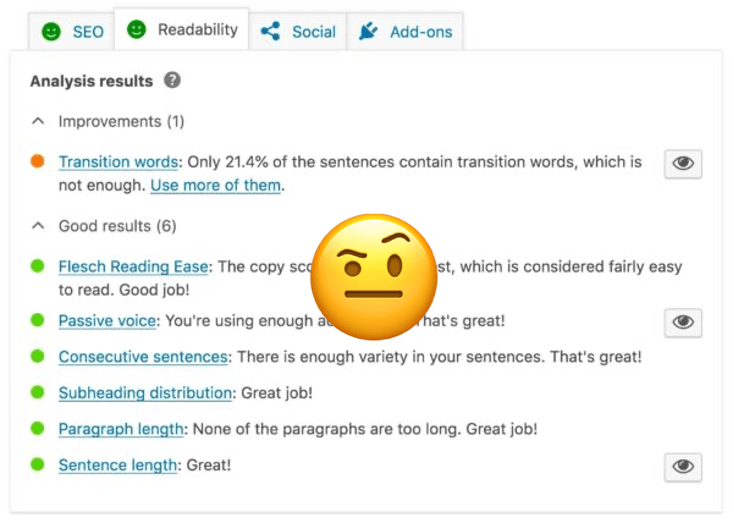
To marketer ears, “readability” inevitably conjures that familiar WordPress plugin: Yoast SEO. If you’ve never had the pleasure of using it, this is a Yoast feature that—with the help of a mysterious algorithm—calculates the reading “difficulty” of a piece of writing.
It then makes recommendations like decreasing sentence length, using a more active voice, and breaking up large chunks of text with subheadings. It’s even audacious enough to put red or orange bullets next to posts it considers algorithmically sub-par, but let’s not get into that.
Transition word problems: First, I’m going to scatter transition words everywhere. After that, I’ll secure a green bullet. In conclusion, I’m going to throw my writing out the window.
Yoast’s bottom line is that readability ranks. But the definition of readability continues to evolve with technology like NLP (Natural Language Processing). It’s taking on a more human form. In this post, I’m going to provide five ways to improve the human readability of your content which, in turn, will improve its algorithmic readability too. They include:
- Lose the clickbait titles
- Don’t keyword stuff (even if subtle)
- Quit the over-paragraphing
- Nix the bulking out of how-to posts for no reason
- Resist over-formatting
- Link with mercy
Why HUMAN readability is important
As mentioned above, readability ranks. They say greater reading ease:
- Improves user experience.
- Increases the chances of your post ranking well for voice search.
- Appeals to search engines that are increasingly attuned to what human beings perceive as worthwhile writing.
Now, I’m personally skeptical of any algorithmic approach to writing. I have little patience for the Yoast plugin’s decrees, writing tools like Grammarly, or anything that attempts to interfere with my thoughts when I’m writing (sighs in predictive text).
But Yoast touches on something significant here, and something that often gets lost in the chaotic box-checking process of SEO writing: your reader is not the search engine itself, but a person expecting a sense of linguistic cohesion. And with Google’s NLP advancements, you can (read: should) actually consider the search engine a person, too—to an extent.
Focusing on ranking for keywords is an effective tactic to drive traffic to your website—but if you lose sight of the fact that you’re writing for readers and not Google, you’re doing it wrong. This is the kind of attitude that leads to articles like this one decrying the way search results now seem to be catering to the interests of algorithms, not users themselves.
I’m serious. To quote said article’s exasperated writer, Nick Slater, writing with only a search engine’s interests in mind results in “a masterpiece by SEO writing standards and an absolute turd by regular writing standards.” Unsurprisingly, this stuff drives people crazy.
Writing with only a search engine’s interests in mind results in “…a masterpiece by SEO writing standards and an absolute turd by regular writing standards.”
How to improve your content readabilty for SEO
On that note, for the sake of your readers’ sanity, here are a few steps you can take to improve the human readability of your content.
1. Lose the clickbait titles
We’re all pretty used to the internet by now. Maybe a dramatic blog post title like “[X number] of Content Marketing Mistakes That Will Blow Your Mind’” would’ve worked in 2010, but now we just roll our eyes and keep scrolling.
The same goes for any highly exaggerated anticipation of the reader’s reaction: If I see a headline that promises to be “ultimate,” “revealed,” or “revolutionary,” I skip right over it. (Ditto for titles that guarantee unimaginable success as a result of reading that post.)
‘Shake Off the Shackles of Ordinary Headlines TODAY!’
A little showmanship is okay
It’s fine to retain a little bit of showmanship in a title, but keep it down to earth. ‘What You’re Doing Wrong with Your Content Marketing: 5 Common Mistakes,’ as WordStream titles their own post on the subject, still addresses the reader directly, even daring to assume that they’re making mistakes in the first place. But it doesn’t obnoxiously patronize the reader by saying “5 Content Marketing Mistakes You’ll NEVER Believe You’re Making”. The difference, I think, is obvious.
Make sure you fulfill your promise
My point is that you shouldn’t create expectations you aren’t going to meet. Be thoughtful about how you choose your headlines—much like the process of titling a book, what you pick seriously affects the reception of a text. (So much so, in fact, that authors as prolific as Toni Morrison have had their titles changed by their publishers for commercial reasons.)
Your instincts matter
Others have looked extensively into what makes a good headline: Danny Goodwin previously shared his findings after running A/B tests on headlines for 31 days in an insightful post I recommend. Just make sure you don’t lose sight of the fact that, quantifiable metrics and headline analyzers aside, your instincts (informed by your uniquely human understanding of language) most likely still know better.
Follow these tips for writing great headlines and you’ll be as good as gold.
2. Stop the keyword stuffing (even the subtle kind)
Good ol’ keyword stuffing. When keyword stuffing occurs, you’ll be sure keyword stuffing is taking place, because every other phrase will contain the same words, in classic keyword stuffing fashion.
Google’s enigmatic algorithm supposedly now knows better than to take keyword density as an indicator of information quality and relevance, and yet we’ve all searched for things and met with a wall of repeated keywords. So what if there’s useful information amongst all the keywords? I need to be able to find it, and keyword stuffing is an obstacle.
3. Quit over-paragraphing
What is this, a poem?
If not, why the line breaks?
Are you typing this on your phone?
A 5-word sentence is not a paragraph, even on smartphones.
Stop throwing your reader off!
Whether you’re writing a blog post or an email, micro-paragraphs are seriously distracting. As soon as they start saying something, they suddenly get cut off at the windpipe, gaping at you wide-eyed and short-lived. I’m not sure what the thinking behind this tendency is (if it’s “better readability,” then I weep for the human race), but the good news is that it’s an easy thing to fix.
There’s a time and a place
Just aim to be more mindful of when you press ‘enter’—and if, after a second glance, it seems there’s no reason for you to change lines, just don’t do it. Second-guessing yourself is actually a key step towards becoming a better writer, so feel free to have a full-blown existential crisis over every minor decision. Congrats, you’re a writer now!
(In all seriousness, here’s a resource on self-editing if you need one.)
Take a look at this example from a post on online presence. In the red box, every sentence feels like a profound statement. Is this a list? Are they separate ideas? What is the key takeaway from this collection of lines? In the green box, the key takeaway is isolated as its own line with supporting information above it.
Reserve single sentence paragraphs for strong statements.
>> 9 Free Blog Post Templates Guaranteed to Drive Traffic
4. Nix bulking out how-to posts for no reason
People Google all sorts of things, so as an SEO writer, you’ll often have to do some intellectual gymnastics to come up with effective answers to everyone’s queries: You might be working on “how to be happy” one day, and “how to use chopsticks” the next.
You’re not in high school anymore
“How to be happy” might warrant a lengthy, meditative piece of writing, but you could probably knock out “how to use chopsticks” in two or three practical steps. The key thing to remember is that this isn’t your high school coursework, and you don’t need to bulk out your writing until you reach a certain word count.
You could actually come off as condescending
If anything, over-explaining simple tasks comes across as patronizing (not to mention boring), and achieves the opposite of user-friendliness. Keep it simple, and respect your reader’s time, as well as your own.
(In case you were wondering, “how to be happy” currently has a U.S. monthly search volume of 27,000, whereas “how to use chopsticks” gets 31,000 searches, according to Ahrefs. You might think people have their priorities wrong, but you could also argue that noodles, in fact, are a more dependable path to true happiness.)
5. Resist over-formatting
Anxiety about “skimmability” sometimes manifests as excessive formatting. Headers become larger, maybe even presented in a different font, to improve navigation. Great!
- One or two words italicized? Sure.
- Information broken into short bullet points? Fair enough.
- Occasional bolding to call out important information? Sounds good.
But if half the text is bright blue with hyperlinks, if it looks like a pinata of headings and subheadings exploded, or if there are five different fonts competing for your attention on a single page? Not so good.
Winnie isn’t sure what “skimmable” means anymore.
Skimmable content should not be busy content
There’s a reason typography is usually left to the experts (at least in print): because they know how to establish a sense of visual hierarchy, so your attention goes exactly where it should. For those of us sadly not blessed with professional typographic skills, overcompensating with loads of formatting is not the way to go. Make the most of your headers and bullets, but if more of your text is more formatted than not, you need to reevaluate.
Stick to your header tags, people!
6. Link with mercy
One last thing: Yes, internal and external linking are important, but try not to abuse the number of links you include in a piece of writing. Ideally, aim to never exceed two links in a single paragraph—otherwise you risk distracting the reader. If you really do have a lot of important resources to share, consider listing them at the bottom of an article as recommended reading.
Do NOT take a page out of Wikipedia’s book.
Use links strategically
But more than that, be careful with the kind of links you include in a post. You might not be entirely in control of what you have to link to as part of your job, but you are in control of how you employ links within the text.
In this post, for example, all links point to
a) The definition of a term it’s attached to, in case clarification is needed,
b) The source for a specific claim, or
c) There’s a more in-depth guide to a related topic I mention in passing. I didn’t link a random chopsticks post when I mentioned noodles, awkwardly ignoring it and continuing on, allowing the unacknowledged irrelevant link to silently glare at us both.
Relevancy is key
You might be thinking that I’d have no choice but to link to a random chopsticks brand if that was who I worked for—but I wouldn’t then be writing a post about marketing. I’d be writing about chopsticks, and the link would be relevant.
SEO readability is not formulaic anymore
I hope it’s clear by now that readability is far more than a formulaic plugin box to check! As one of the main pillars of good content, it’s about mindset as much as it is about individual writing choices. Some websites might currently be getting away with prioritizing the algorithm’s needs, but as the algorithm itself becomes more sophisticated and (yikes!) human-like in its preferences, writing that factors in human readability will rise to the top. And it’ll do that because people simply won’t hate to read it.
Thinking you might need to go back into your content and make some changes? Use our content audit guide (with 6 free templates) and it will make your life a lot easier.
About the author
Kleopatra Olympiou is a writer with Reedsy, a marketplace that connects authors and publishers with the world’s best editors, designers, and marketers.


